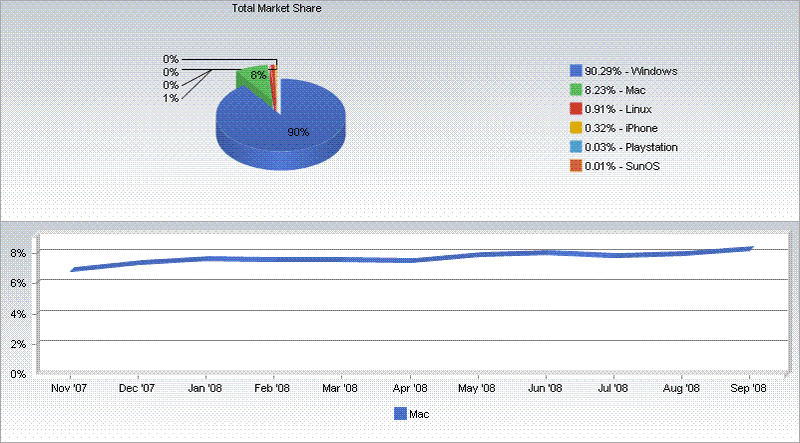Macs accounted for 8.23 percent of all traffic on Web sites tracked by the firm during the month of September, up from 7.86 percent the month before. Those gains came largely at the expense of rival systems running flavors of the Windows operating system, which saw their combined share slip from 90.66 percent to 90.29 percent.
Also on the rise was the share of Web traffic coming from iPhones, which inched up nearly 7 percent from August to garner a combined 0.32 percent share. Those gains, however, pale in comparison to the more than 57 percent leap made by the touchscreen handsets immediately following the release of the iPhone 3G in July.
Meanwhile, Apple's Mac- and Windows-based Safari web browser also maintained its forward progress during the month of September, with its share climbing a bit over 4 percent.
The largest gains in the browser space came by way of Google, whose new Chrome offering snagged a 0.78 percent share of all web traffic during its first partial month on the market.
 Sam Oliver
Sam Oliver








 Malcolm Owen
Malcolm Owen
 Amber Neely
Amber Neely
 Christine McKee
Christine McKee


 William Gallagher
William Gallagher
 Chip Loder
Chip Loder
 Brian Patterson
Brian Patterson


-m.jpg)






27 Comments
More and more consumers are choosing Apple computers to access their favorite online content, with the presence of Macs on the Web growing more than 4.7 percent last month, according to the latest market share figures from Net Applications.
4.7% X 12 months=56% growth pa. AAPL has got to go up if this trend continues even for the next 3-4 months. It confirms apples greater acceptance and uptake versus the rest of the industry. Is this a good metric, given new OSX users might browse more.... not really, iPhone yes, but not on Mac OSX.
Can this method be used to measure the contribution that iTunes data has made to internet traffic. ie can hi def d/l inflate OS usage?
Edit added last line.
Just as important as the Mac climbing up is Windows' slide toward 90%.
90% is considered somewhat of a magic number, over which one has a monopoly... and under which one does not. It looks like Windows is about to lose it's iron grip.
Notice how the tone has changed already? People used to say their software runs on Mac and Windows. Then they stopped saying that, figuring practically everyone uses Windows anyway. Now the phrase is back. Developers can't ignore Macs anymore, unless they want to lose one in ten potential customers.
I'm not sure what the point of breaking out iPhone numbers is in this analysis. If it's OS based, then iPhone numbers should be added into the Mac.
I am sure that the mobile Windows and mobile Linux numbers are just too small to register by themselves and so are added into the desktop figures, but if so then surely iPhone should similarly be blended into the desktops figures.
This should be two charts, one with just the OS numbers and a second one dealing with the battle of the much much smaller mobile versions of the same OS's. iPhone's numbers are really only relevant compared to other mobile platforms anyway.
I'm not sure what the point of breaking out iPhone numbers is in this analysis. If it's OS based, then iPhone numbers should be added into the Mac.
I am sure that the mobile Windows and mobile Linux numbers are just too small to register by themselves and so are added into the desktop figures, but if so then surely iPhone should similarly be blended into the desktops figures.
This should be two charts, one with just the OS numbers and a second one dealing with the battle of the much much smaller mobile versions of the same OS's. iPhone's numbers are really only relevant compared to other mobile platforms anyway.
They have many more stats broken down on their site.
WinCE-based devices register as 1/6th of OS X iPhone with 0.06% and S60-based devices register at 1/11th of OS X iPhone-based devices with 0.03%.
4.7% X 12 months=56% growth pa.
Edit added last line.
For exponential growth 1.047^12 = 1.73; so it's 73% per 12 months.